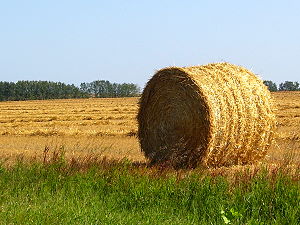 Crop Report Prepared by: Manitoba Agriculture, Food and Rural Initiatives GO Teams & Crops Knowledge Centre October 11, 2011 |
Crop Report Prepared by: Manitoba Agriculture, Food and Rural Initiatives GO Teams & Crops Knowledge Centre October 11, 2011 |
Northwest Region
Warm, dry conditions continued through the week. The Northwest Region received 15 to 25 mm of rain over the weekend. Harvesting of crops is complete through the Swan River and Roblin areas. In the Eastern areas where spring excess moisture delayed seeding, some cereal, canola, hemp, flax and soybean fields remain to be harvested.
For the Northwest Region, yields of hard red spring wheat averaged 45 bushels per acre with 70% grading 1CW. Oats averaged 75 bushels per acre with 70% grading 2CW. Average barley yield is 55 bushels per acre with 75% grading 1CW. Canola graded 90% 1CAN with yields averaging 40 bushels per acre. Swan River and Roblin production is approximately 20% higher than the regional average. In the areas from Grandview and east of the Escarpment to Lake Manitoba, yield and quality averages are 20 to 25% lower than the regional average. Hemp yields are 600 to 800 pounds per acre; seed size and quality are very good. At Ste. Rose, soybeans yields are as high as 40 bushels per acre; however, area average ranges from 20 to 25 bushels per acre.
Yields were reduced where excess spring moisture resulted in drown-outs, poor root development and nutrient losses. Late seeded crops also saw reduced yields due to heat and drought stress. Fusarium damaged kernels and higher incidence of ergot have been the main downgrading factors in wheat. As well, frost damage on immature crops contributed to light weights in barley and oats and small seed and higher green seed counts in canola. Yield and quality impacts due to insect pest problems were generally localized. A variety of insects including Bertha armyworm, flea beetles, diamondback moth larvae and Lygus impacted canola production. While some late seeded wheat was sprayed for wheat midge, evidence of seed damage is low. Some treatments for aphids on soybeans and barley also occurred.
Winter wheat acres increased significantly in the Eastern area of the region with many producers planting into unseeded fields. Winter wheat, fall rye and perennial seed forages germinated evenly and are establishing very well.
Surface soil conditions have been dry and soil temperatures remain high. Some fall fertilizing has begun;with the recent rain and falling soil temperatures, widespread application activities are expected. Most producers are well into fall field work, weed control, straw baling and hauling. Silaging of corn and late seeded greenfeed is continuing.
Winter feed supplies are adequate for the region. Localized shortages exist where Lakes Manitoba, Dauphin and Winnipegosis flooded tame and native hay lands. Overall level of livestock feeding is equivalent to last year, except where flooding has impacted pasture and forage production.
